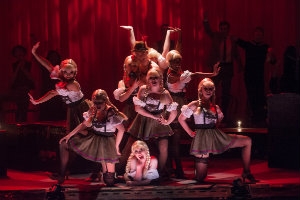Arts
Looking Forward

A conversation with Dan Abraham, professor of music and chair, Department of Performing Arts Jack Rasmussen, director and curator, American University Museum; Zoë Charlton, associate professor of studio art and chair, Department of Art; and Tim Doud, associate professor, Studio Art Program.
Q: What are the biggest influences on the arts today?
Jack Rasmussen: Artists have always been shaped by the ideas, beliefs, and values of the cultures that produced them: capitalism, popular culture, and social and political convictions. The best artists find their own voices in their work and show us who we are now and who we can become.
Zoe Charlton AND Tim Doud: Artists are pursuing very different things at the same time, without the kind of hierarchy that gives advantage to one approach over another. You’ll see artists who paint, make videos, create sculpture, curate exhibitions, and write criticism, all of which are a part of a studio practice.
Dan Abraham: Politics and popular culture have always played a significant role in the creation of art. In the nineteenth century, they were inseparable, but now we find a divide. Artists are often either operating outside popular culture, or they are using popular culture as a device to infuse their art. In today’s globally connected world, artists require much greater entrepreneurial skills than past generations did. Politics, on the other hand, has always been an area for the artist to provide social criticism and reflection. It is a responsibility of those who create.
Q: How do you see artistic expression evolving over the next decade, both in general and at AU?
Zoe Charlton AND Tim Doud: At American University, we expect to see an increase in applications from artists who are influenced by pluralism in the art world, alongside artists whose interests lie in traditional media such as painting, drawing, and print- making. Student interest often reflects what is occurring outside of academia. We see art students reaching outside the Art Department to make connections, to mine for content more meaningfully, and to create broader contexts for their practices.
Dan Abraham: Technology will continue to provide very exciting possibilities that we cannot envision today. Ten years from now there will be modes of expression and engagement with art that we simply cannot recognize as even possible from our current perspective. I also think, however, that traditional forms of art will continue to flourish or even have a resurgence, as the limits and boundaries are pushed to an extreme.
Jack Rasmussen: Visual art media will continue to evolve, and time-based art (video, performance, digital animation) will continue to morph and flourish. There will still be artists making objects that do not move, that are made of real stuff, not virtual, and that occasionally smell of oil and turpentine. What will not change is the artists’ use of their emotional intelligence to express what it is to be human in our times.
Q: How do you decide what exhibitions, performances, and visiting artists to feature at AU?
Jack Rasmussen: I want exhibitions that won’t be shown anywhere else. I find artists by going to exhibitions and studios, and by word of mouth. I watch them develop, and when I feel they have reached a certain maturity and originality I will look for the right context to exhibit their work.Zoe Charlton AND Tim Doud: Studio art brings in artists who have practices that reflect the larger professional art world, such as Michelle Grabner, Titus Kaphar, Renée Stout,Marina Abramoviç, and Jeremy Deller. All of these people are entrenched in the contempo- rary art world. We bring in artists who are relevant, who have broad practices—they write, they curate, they teach, they make art.
Dan Abraham: Some works are more part of a tradition and speak to styles or processes our students need to explore in order to grow as young artists. Other works or programs challenge the norms and provide something new and interesting for both the participants and the observers.
Q: How optimistic are you that smaller or more focused collections and galleries can survive?
Zoe Charlton AND Tim Doud: It may be that different organizational models must be used, like collectives and collaboratives. There are models of university art programs with autonomous museums. At AU, the Studio Art Program has made a conscious decision to connect and collaborate with a variety of institutions and arts organizations in the area, which brings AU into the larger discussion.Jack Rasmussen: I think as long as you stay true to your mission and earn the support of your community, you have a pretty good shot at surviving.
Q: Finally, what are your hopes for the arts at AU in the next ten years?
Dan Abraham: To become a more visible and interesting site for the campus community and the general public to explore all of the arts. And to establish our academic programs as national leaders in providing broad based liberal arts-centered teaching and learning.
Jack Rasmussen: My hope is that the American University Museum, and the Katzen Arts Center in general, will serve as the new center for the arts in Washington. This is already happening as we prepare for the inauguration this coming January of the Alper Initiative for Washington Art.Zoe Charlton AND Tim Doud: Strong funding helps us maintain the relationships we’ve established with arts organizations in DC and in other cities. We have enthusiastically embraced one of the university’s objectives in its strategic plan—developing relationships with institutions in the greater DC metro area.
